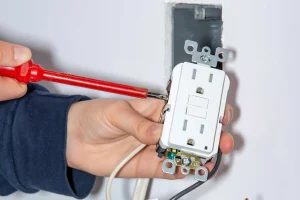Selecting the perfect outdoor lighting solutions is crucial for creating a welcoming ambiance in outdoor spaces. With numerous options available, it can be daunting to choose the best approach. Tailoring lighting choices to enhance functionality, safety, and aesthetics based on the specific needs of the outdoor area is key for homeowners and designers. But how can one navigate the selection process and combine lighting elements effectively to elevate the overall design?
Key Takeaways
- Consider the specific purpose and location of the outdoor space to determine the ideal illumination level and color temperature.
- Choose fixtures that provide sufficient brightness, can withstand outdoor elements, and complement the space’s aesthetic.
- Balance aesthetics and functionality by selecting lighting solutions that enhance visual appeal while supporting the space’s intended use.
- Layered lighting, color temperature, and fixture placement are key elements to consider when creating a warm and welcoming ambiance.
- Select fixtures that support the space’s functional needs, such as task lighting for outdoor kitchens or accent lighting for landscape features.
Understanding Outdoor Lighting Needs
Outdoor lighting needs vary widely depending on the specific purpose and location, with different areas requiring distinct illumination levels, color temperatures, and fixture types to achieve ideal ambiance and functionality. When selecting outdoor lighting solutions, it’s crucial to consider these factors to create a unified and inviting atmosphere. Tips for selecting the best outdoor lighting solutions involve understanding these subtleties to improve your design and paver projects.
Assessing Lighting Function and Purpose
What specific tasks and activities will the outdoor space accommodate, and how can the selected lighting solution effectively support and improve these functions? When selecting outdoor lighting solutions, it’s crucial to consider the purpose of the space. Will it be used for entertainment, relaxation, or safety? Tips for selecting the best outdoor lighting solutions involve understanding the functional needs of the space to create a unified ambiance.
Selecting the Right Lighting Fixtures
With a clear understanding of the outdoor space’s functional needs, the next step is to select lighting fixtures that not only fulfill but enhance the ambiance and purpose of the area. When choosing fixtures, consider the following key factors:
- Lumen output: Make sure the fixture provides sufficient brightness for the space.
- Material durability: Choose fixtures that can withstand outdoor elements.
- Style and design: Opt for fixtures that complement the outdoor space’s aesthetic.
Balancing Aesthetics and Functionality
While outdoor lighting solutions often serve a practical purpose, they can significantly enhance the visual appeal of a space, making it vital to strike a balance between aesthetics and functionality. When selecting outdoor lighting solutions, consider the style and architecture of your home, along with the desired ambiance and level of illumination, to achieve a harmonious blend of form and function.
Enhancing Ambiance With Outdoor Lighting
Outdoor illumination options have the extraordinary ability to transform an ordinary outdoor space into an inviting oasis, elevating the ambiance and creating a warm, welcoming atmosphere. To achieve this, consider the following key elements:
- Layered Lighting: Combine ambient, task, and accent lighting to create visual interest.
2. Color Temperature: Select a warm white (2700K-3000K) or cool white (3500K-4100K) tone to suit your desired ambiance. - Fixture Placement: Strategically position fixtures to highlight architectural features and create pools of light.

Frequently Asked Questions
How Do I Determine the Ideal Lumen Output for My Outdoor Space?
To determine the optimal lumen output for your outdoor space, consider the area’s size, task requirements, and desired ambiance, and consult the Illuminating Engineering Society’s guidelines for recommended foot-candle levels.
Can I Install Outdoor Lighting Solutions Myself or Do I Need a Professional?
While it’s possible to install outdoor lighting solutions yourself, hiring a professional is recommended to guarantee safety, ideal placement, and compliance with local electrical codes, securing a radiant ambiance that enriches your design and paver projects.
What Is the Difference Between Warm White and Cool White Outdoor Lighting?
When choosing outdoor lighting solutions, it’s crucial to understand the difference between warm white (2700K-3000K) and cool white (3500K-5000K) lighting, as warm white emits a cozy, yellowish tone, while cool white produces a bright, bluish light, each suiting distinct ambiance and design requirements.
Are Solar-Powered Outdoor Lighting Solutions a Cost-Effective Option?
Solar-powered outdoor lighting solutions can be a cost-effective option, offering energy efficiency and reduced maintenance costs, while providing a sustainable and eco-friendly alternative to traditional lighting solutions.
How Often Should I Replace Outdoor Lighting Fixtures to Maintain Optimal Performance?
To maintain peak performance, outdoor lighting fixtures should be replaced every 5-7 years or when showing signs of deterioration, such as corrosion, fading, or diminished light output, to guarantee continued safety and aesthetic appeal.
Conclusion
Achieving ideal outdoor lighting solutions involves evaluating, and balancing aesthetics and functionality, considering the specific functions and purposes of the outdoor space. By appraising lighting needs, selecting suitable fixtures, and harmonizing ambient, task, and accent lighting, a cohesive ambiance can be created. This synergy of form and function enriches the overall design and atmosphere of the outdoor space, ultimately elevating the paver project. Effective outdoor lighting solutions thus become an integral component of a well-designed and functional outdoor area.
You May Also Like:

